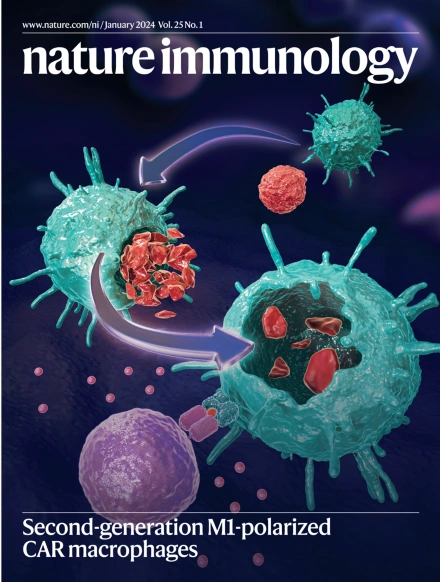短暂的组织驻留和淋巴输出定义了人类CD56bright NK细胞的稳态。
IF 27.6
1区 医学
Q1 IMMUNOLOGY
引用次数: 0
摘要
人类组织驻留(TR) CD56bright自然杀伤(NK)细胞可以通过从小鼠研究中推断的整合素和趋化因子受体的表达来识别,但其稳态的许多方面尚不清楚。本研究采用动态人、人源化小鼠和非人灵长类动物模型和传出淋巴液取样的综合方法来确定人类NK细胞的再循环和TR模式。通过血管内标记,我们发现CD56bright NK细胞在稳定状态下进入组织壁龛。此外,在人肝移植中,供体来源的CD56bright NK细胞在移植后早期代表了主要的TR NK细胞群,但随着时间的推移,被浸润的受体NK细胞所取代,这些NK细胞建立了TR特征,这一过程部分由Runx3调节。瞬时TR cd56亮NK细胞通过淋巴循环,在引流淋巴结和传出淋巴液中显示一致的表型,在淋巴结出口阻断时从外周血中减弱。最后,CD56dim NK细胞在稳定状态下被限制在脉管系统中,在炎症发生时进入淋巴结。本研究为人类NK细胞群的短暂组织驻留和再循环模式提供了一个机制框架。本文章由计算机程序翻译,如有差异,请以英文原文为准。
Transient tissue residency and lymphatic egress define human CD56bright NK cell homeostasis.
Human tissue-resident (TR) CD56bright natural killer (NK) cells can be identified by expression of integrins and chemokine receptors inferred from murine studies, but many aspects of their homeostasis are unclear. Here we used an integrated approach of dynamic human, humanized mouse and non-human primate models and sampling of efferent lymph fluid to determine recirculation and TR patterns of human NK cells. By intravascular labeling, we showed that CD56bright NK cells access tissue niches at steady state. Furthermore, in human liver transplantation, donor-derived CD56bright NK cells represent the dominant TR NK cell population early after transplantation, but are replaced over time by infiltrating recipient NK cells that establish TR traits, a process partly regulated by Runx3. Transient TR CD56bright NK cells recirculated via lymphatics, displaying a consistent phenotype detectable in draining lymph nodes and efferent lymph fluid, and waned from peripheral blood on lymph node egress blockade. Finally, CD56dim NK cells, constrained to vasculature at steady state, entered lymph nodes upon inflammation. This study provides a mechanistic framework for the transient tissue residency and recirculation pattern of human NK cell populations.
求助全文
通过发布文献求助,成功后即可免费获取论文全文。
去求助
来源期刊

Nature Immunology
医学-免疫学
CiteScore
40.00
自引率
2.30%
发文量
248
审稿时长
4-8 weeks
期刊介绍:
Nature Immunology is a monthly journal that publishes the highest quality research in all areas of immunology. The editorial decisions are made by a team of full-time professional editors. The journal prioritizes work that provides translational and/or fundamental insight into the workings of the immune system. It covers a wide range of topics including innate immunity and inflammation, development, immune receptors, signaling and apoptosis, antigen presentation, gene regulation and recombination, cellular and systemic immunity, vaccines, immune tolerance, autoimmunity, tumor immunology, and microbial immunopathology. In addition to publishing significant original research, Nature Immunology also includes comments, News and Views, research highlights, matters arising from readers, and reviews of the literature. The journal serves as a major conduit of top-quality information for the immunology community.
 求助内容:
求助内容: 应助结果提醒方式:
应助结果提醒方式:


